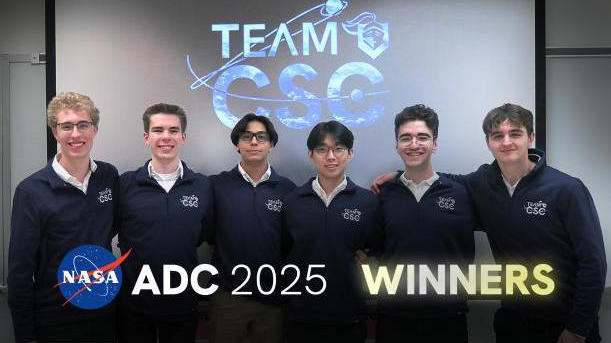Houston, we have our winners; Prospect coders conquer app challenge

Published March 31, 2025
It may not be “to infinity and beyond,” but an April trip to the Johnson Space Center in Houston nonetheless represents a big leap for a group of Prospect High School coders.
NASA recently named six PHS students – Team CSC (Computer Science Club) – as finalists in the space agency’s App Development Challenge (ADC). In this coding challenge, NASA poses technical problems to middle and high school students with the goal of seeking student contributions to deep space exploration missions.
The mission, in this case, is Artemis, NASA’s project to return humans to the moon for the first time since 1972. More specifically, students had 10 weeks to create a video showcasing their app, which is to visualize the flight path of Artemis II, while indicating which antennas would communicate with Earth in real-time. Top-rated teams – including Prospect’s Albert Kim, Oliver Lach, Matthew Lundeen, Efe Ozalp, Christopher Pawlak and Sharul Shah – then discussed their app via video calls with subject matter experts from NASA’s Space Communications and Navigation (SCaN) team.
Lead teacher Paul Hennig said, “I'm just so proud of them. They worked so hard and spent a lot of time completing this challenge.”
For Ozalp, founder and co-president of the Computer Science Club, the achievement validates years of hard work. “It brings me so much joy to see the CSC grow from the small group I founded in my sophomore year into a team of fantastic developers who won a remarkable national award,” he said. “We were all buzzing with excitement when we learned we had been selected, because it meant all the hard work we put into our app had paid off, and we couldn’t have done it without Mr. Hennig’s endless support.”
In announcing Prospect as a finalist, judges noted that their app included key details, such as spherical camera movement, and also that NASA’s antennas were placed accurately on a model earth. Ozalp said the team’s interaction with NASA professionals paid dividends that will extend well beyond the coding challenge.
“It was a great test of our presentation skills,” he said. “Not only did we have to enhance our skills in the coding scheme, but we also had to learn how to make our workflow clear to the judges and improve based on their feedback. The skills we gained from this process will be invaluable in our future development endeavors.”
From April 14-17, Prospect students will enjoy a behind-the-scenes tour of the Johnson Space Center.

